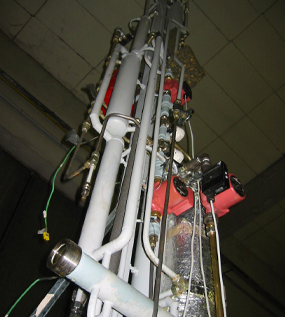 |
 |
|
Was a few decades ago as common as is today the compressor chiller, but slowly disappeared when compressors were getting better and cheaper. The principle: ammonia is extremely soluble in cold water and much less in hot water. When a water ammonia solution is heated it expels its ammonia. After dissipating the heat, the ammonia gas – still under high pressure – liquefies. When the pressure of this liquid ammonia is lowered, it evaporates producing a cooling effect. The ammonia gas then meets a surface of cold water, which absorbs the ammonia again, closing the cycle.
The fact that the ammonia liquefaction needs a higher pressure than the absorption process leads to a technical problem. Therefore classical ammonia-water-absorption cooling machines use an electrical pump to move the ammonia water solution. These pumps need a lot of maintenance and use energy. |
Another way to solve the pressure problem is applied in diffusion absorption cooling machines. An inert gas is used additionally to water and ammonia. Now the pressure is equal in all areas of the system. Only the partial pressure of the ammonia vapour is different. Like this these machines don't require an electrical pump.
However the general problem of conventional ammonia absorption cooling machines is that they only work with heating temperatures of about 150°C which cannot be achieved with simple solar collectors. Their efficiency (COP) is relatively low: 0.3 to 0.7. |